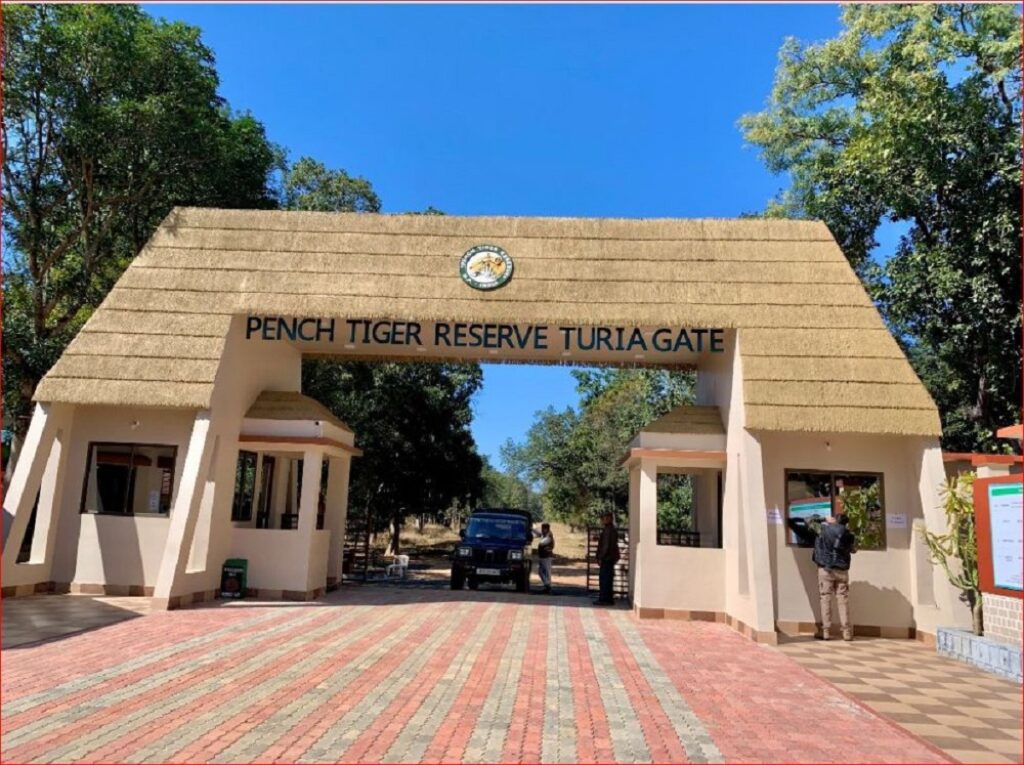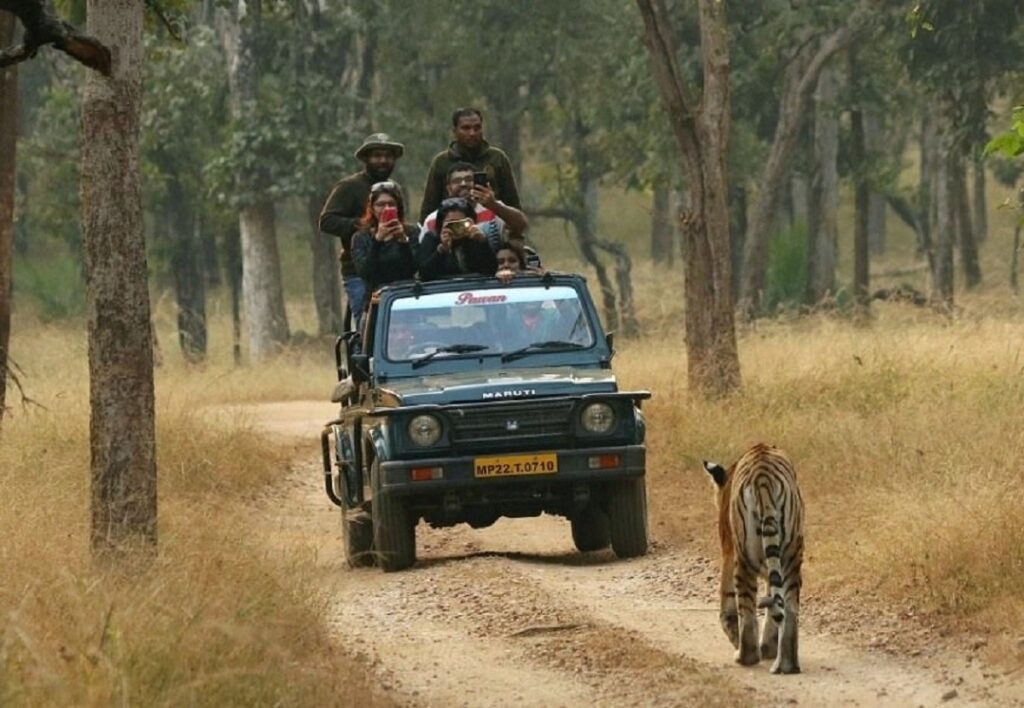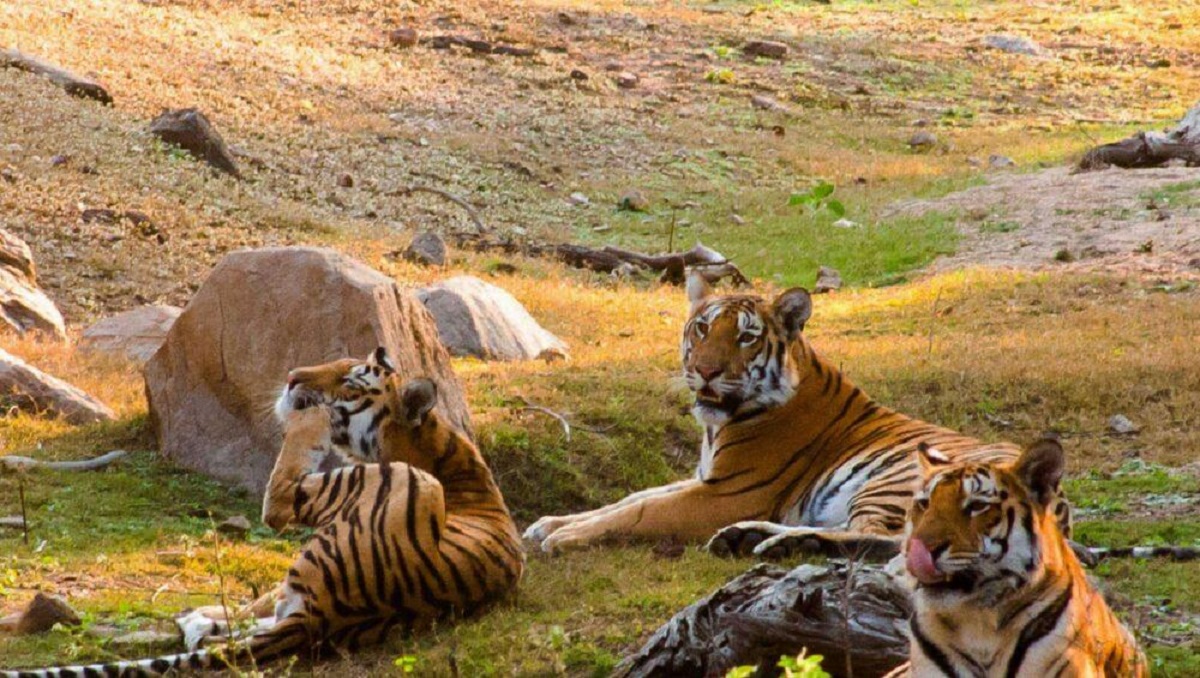Nestled in the heart of India, Pench National Park is a paradise for wildlife enthusiasts and nature lovers alike. Straddling the states of Madhya Pradesh and Maharashtra, this park is renowned for its diverse ecosystem, rich biodiversity, and connection to Rudyard Kipling’s timeless classic, The Jungle Book.
Pench National Park derives its name from the Pench River, which meanders through the park and sustains its lush forests and thriving wildlife. It was declared a sanctuary in 1965 and later designated as a national park in 1975. With its storied history, it’s no surprise that Pench National Park is one of the most revered national parks. Here’s our comprehensive guide on Pench National Park;
Please Download Our Mobile App here.
Overview of Pench National Park
Nestled in the heart of Madhya Pradesh, Pench National Park sprawls across the districts of Seoni and Chhindwara. The park was also behind Rudyard Kipling’s The Jungle Book—a timeless tale that cemented Pench’s place among the world’s most famous wildlife reserves. Its rich and diverse landscape is shaped by the meandering Pench River.
This pristine waterway divides the wilderness into two lush halves, creating a thriving ecosystem that has long been celebrated for its biodiversity. Spanning an impressive 99.33 square miles (257.26 sq km) within Madhya Pradesh, the park is part of a larger protected area totaling 758 square kilometers. The significant portion is in Maharashtra.
With an elevation ranging from 1,394 to 2,034 feet (425 to 620 m), visitors can embark on thrilling jungle safaris from either state. The terrain is gently undulating, dotted with small hills that add depth to the dense deciduous forests of teak, saja, and other native trees. Pench National Park is divided into seven distinct safari zones: Turia, Karmajhiri, Jamtara, Rukhad, Wolf Sanctuary, Sillari, and Khursapar.
Among them, Turia stands out as the prime location for tiger sightings, thanks to its numerous water bodies that attract a variety of animals. For those seeking a more unconventional adventure, the Wolf Sanctuary provides a thrilling option, as it is the only zone where night safaris are permitted.
Wildlife in Pench National Park

Pench National Park, with its lush grassy meadows and dense undergrowth, serves as a thriving sanctuary for a diverse range of wildlife. Among its most sought-after inhabitants is the majestic Bengal tiger, a sighting that remains at the top of every visitor’s wish list.
The park is also home to an impressive lineup of predators, including the elusive Indian leopard, Indian wolf, jungle cat, hyena, fox, jackal, and wild dog. Beyond these skilled hunters, Pench supports a rich variety of herbivores such as the mighty gaur and the endearing sloth bear. There’s also an assortment of deer species, including sambar, barking deer, chital, and nilgai, as well as wild boar.
Birdwatchers, too, are in for a treat. There are over 210 avian species that either nest or migrate through the park, particularly along its riverbanks where herons, fowl, and other waterbirds thrive. For those eager to explore this wilderness, safaris can be booked through either the Seoni district in Madhya Pradesh or the Nagpur district in Maharashtra.
Best Time to Visit Pench National Park
The ideal time to explore Pench National Park depends on what you want to experience. The winter months (November to February) offer the most comfortable weather. During this window, daytime temperatures hover around the mid-20s°C, though mornings and evenings can be crisp.
During this period, the park’s dense foliage begins to thin, improving visibility for wildlife enthusiasts. Birdwatchers will also find this season rewarding, as both migratory and resident birds fill the landscape. However, this is a peak tourist season, so booking safaris in advance is highly recommended.
For those hoping to maximize their chances of spotting tigers, the summer months (March to June) present the best opportunity. With temperatures soaring past 40°C, the intense heat forces animals to gather around the park’s limited water sources, making sightings more frequent. However, the summer conditions can be harsh, so visitors should come well-prepared for the scorching conditions.
Meanwhile, the monsoon season from July to September brings heavy rainfall, rendering many trails impassable. During this time, the park remains closed to visitors, allowing the ecosystem to rejuvenate before reopening for the next season of wildlife adventures.
Getting to Pench National Park

Pench National Park is well-connected by air, rail, and road, making it easily accessible from both Jabalpur and Nagpur. For those opting to fly, the two main airports serving the region are Dr. Babasaheb Ambedkar International Airport in Nagpur and Jabalpur Airport. Nagpur’s airport, located about 130 km from Pench, is a convenient choice for both domestic and international travelers.
On the other hand, Jabalpur Airport, about 213 km away, caters exclusively to domestic flights. Upon arrival, taxis are readily available to take you to the park. If traveling by train, Seoni Railway Station in Madhya Pradesh, just 72 km away, is the closest railhead, with good connectivity to major cities across India.
Alternatively, Jabalpur Railway Station, 205 km from Pench, serves as another viable option. Buses are also a seamless choice, especially via Seoni, a city in Madhya Pradesh that acts as a gateway to the park. You can also hire a taxi from nearby towns and cities if you hate the inconveniences of public transport.
Other Activities in Pench National Park
While the park is primarily known for its diverse wildlife, visitors can explore its beauty on foot through guided trekking tours. These treks offer a more intimate connection with nature, allowing adventurers to take in the sights, sounds, and scents of the forest while getting some exercise.
For those seeking a true “Jungle Book” experience, stepping into the dense wilderness on a guided walk is a must. Jungle safaris remain the park’s highlight, giving visitors the best chance to spot its fascinating wildlife, from tigers to leopards and countless bird species. This remains the most sought-after activity in Pench.
Park Fees in Pench National Park

Pench National Park requires visitors to pay specific fees for entry and safaris, with costs varying depending on the type of vehicle. A private jeep safari, accommodating up to six people, costs around INR 8,000 ($96). There’s an additional fee of INR 1,000 ($12) per vehicle for foreign visitors entering through the Khusapur and Sillari gates.
Booking a jeep safari requires full payment in advance. For those looking for a more budget-friendly option, a Canter safari is available. Its prices range from INR 1,000 to INR 2,000 ($10–$24) per person.
FAQs
How much is a taxi from Nagpur to Pench?
The cost of a taxi from Nagpur to Pench for a one-way trip starts at around ₹3,500 ($42), though this may vary depending on the type of vehicle and season. If you’re planning a round trip, the fare is calculated at ₹12 per kilometer (about $0.14 per km), with a base inclusion of 300 kilometers. Keep in mind that additional charges, such as toll fees and parking costs, are not included in the base fare and will need to be paid separately.
Is Pench worth a visit?
Absolutely! A visit to Pench National Park is well worth it. The park’s breathtaking scenery, combined with thrilling jungle safaris, offers an unforgettable experience. The diverse wildlife, from deer and langurs to a variety of bird species, makes every game drive exciting.
Conclusion
For those seeking an unforgettable wildlife experience, Pench National Park offers a mesmerizing blend of adventure, tranquility, and nature’s raw beauty. Whether it’s tracking a tiger’s paw prints or simply soaking in the serene jungle ambiance, Pench promises an experience like no other.




